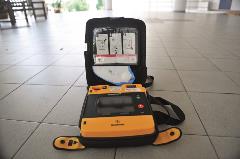-
995
Fire Engine / Ambulance
-
1777
Non-Emergency Ambulance
-
Fire Hazard Reporting
1800 280 0000
-
General Enquiries
1800 286 5555
-
Fire Hazard Reporting
-
General Enquiries
AUTOMATED EXTERNAL DEFIBRILLATORS (AEDs)
Defibrillation increases a casualty’s chances of survival in the event of a cardiac arrest, and it is the only treatment that can restart and restore a normal rhythm to a heart that has stopped beating. The AED is a computerised medical device that is capable of analysing the casualty’s heart rhythm and directs the user to deliver an electric shock to the casualty.

Turn on the AED and follow the machine’s pre-recorded instructions. Ensure that no one, including yourself, comes into contact with the casualty:
- When the AED is analysing the casualty’s heart rhythm; and
- Before you press the ‘Shock’ button.
In both cases, shout to inform people to keep clear.
Follow the AED’s instructions and perform CPR as required until the ambulance arrives or the casualty’s breathing returns, whichever is earlier.
TO PREPARE THE CASUALTY
- Expose the casualty’s chest adequately as defibrillation pads need to be pasted directly onto the skin. Tear or cut off any obstructing fabric if necessary.
- Remove/push aside any jewellery, accessories or medicated patches on the casualty’s chest.
- Shave off excess hair on the casualty’s chest to ensure that the defibrillation pads stick well to the skin.
- Dry the casualty’s chest area of any perspiration and moisture.
- Place defibrillation pads 4 fingers away from pacemakers, if any.
TO APPLY THE DEFIBRILLATION PADS:
- Check the expiry date on the packet;
- Follow the instructions on the packet and remove the pads accordingly;
- Peel off the backing and paste the pads as shown;
- Make sure they are pasted down well with no air pockets; and
- During these actions, CPR must continue uninterrupted.
THE AED CANNOT BE USED IF THE CASUALTY IS:
- Responsive or is breathing;
- A child of less than 1-year-old; or
- Obviously dead.
For children aged between one to eight years or weigh less than 25kg, paediatric defibrillation pads (which have reduced energy output) should be used. However, if there are no such pads, adult defibrillation pads should be considered.
 ) or https:// as an added precaution. Share sensitive
information only on official, secure websites.
) or https:// as an added precaution. Share sensitive
information only on official, secure websites.

